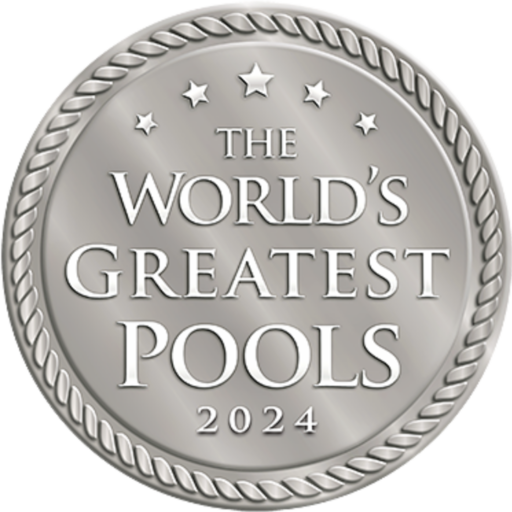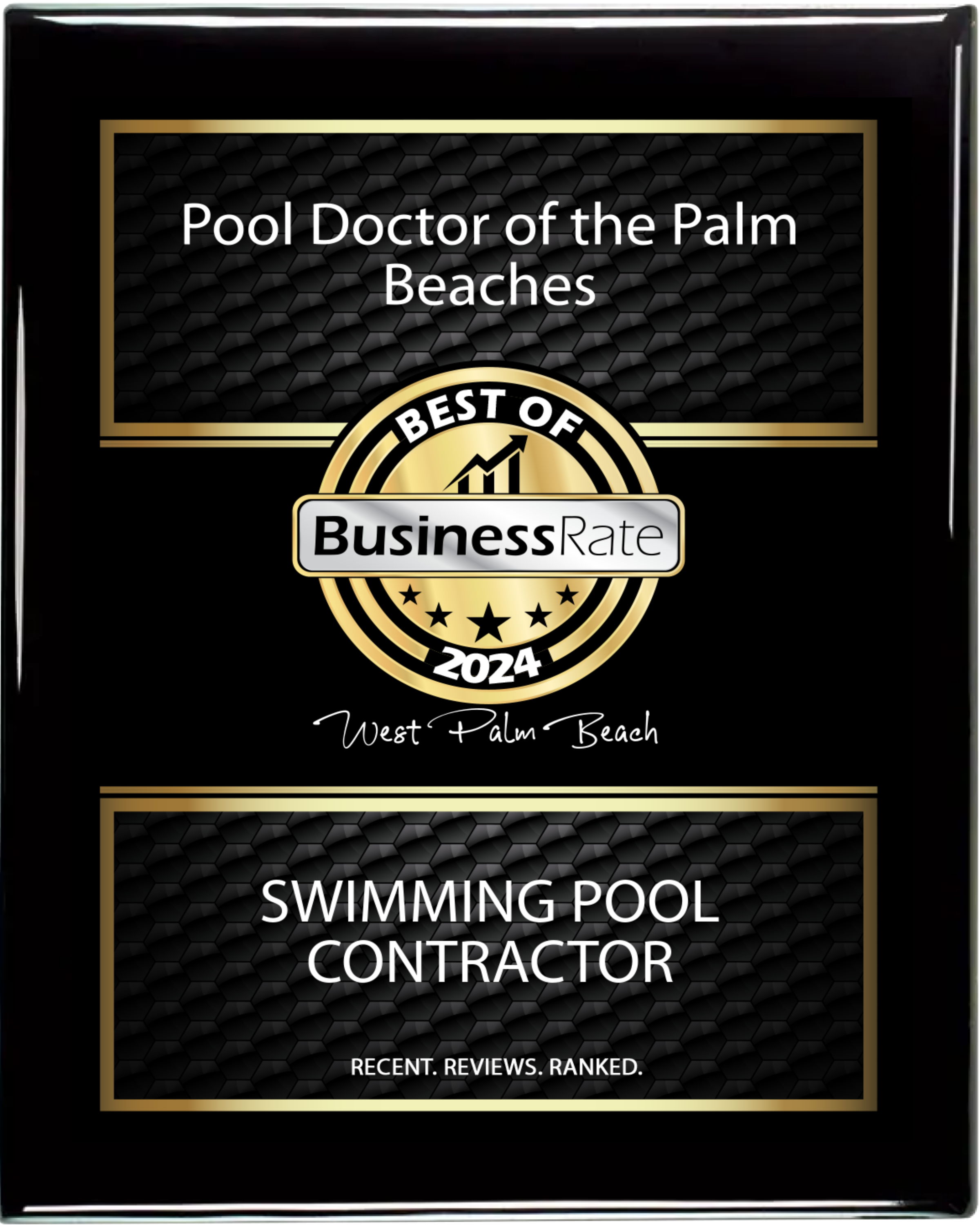Seven proven chemicals can quickly eliminate stubborn mustard algae from your pool. You'll need high-dose shock treatments containing calcium hypochlorite, specialty yellow algaecides, copper-based solutions, quaternary ammonium compounds, concentrated chlorine tablets, multi-action eliminators, and professional-grade sanitizers. Each treatment requires specific application methods and proper pH levels between 7.2-7.6 for maximum effectiveness. Understanding these powerful solutions' correct usage will guarantee your success in combating mustard algae.
High-Dose Pool Shock Treatments
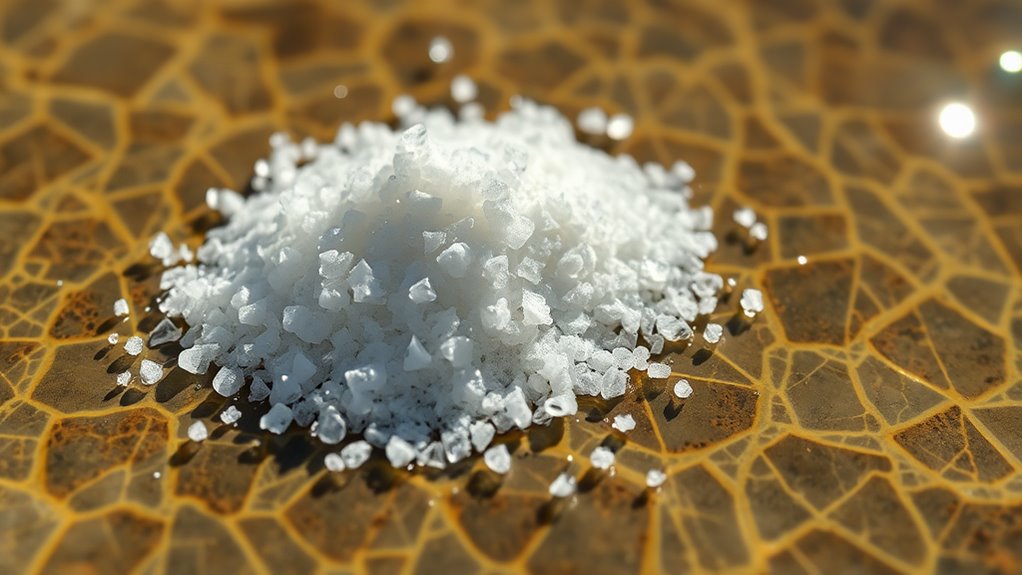
Pool shocking at heightened concentrations serves as the primary defense against stubborn mustard algae infestations. You'll need to triple the standard shock dosage to effectively combat yellow algae, using 3 pounds of calcium hypochlorite per 10,000 gallons of pool water.
For ideal chemical interactions, maintain your pool's pH between 7.2 and 7.6 before administering the shock treatment. High temperature treatments can reduce shock effectiveness, so apply chemicals during evening hours when UV exposure is minimal. You'll want to run your pool pump continuously for 24 hours after shocking to guarantee proper chemical distribution.
Test your water's free chlorine levels after shocking – they should read between 10-30 ppm initially. Once levels drop below 5 ppm, it's safe to resume swimming.
Specialty Yellow Algaecides
While shocking treats mustard algae directly, specialized yellow algaecides provide targeted chemical compounds designed specifically for this stubborn strain. These specialty formulations contain higher concentrations of copper sulfate and quaternary ammonium compounds that penetrate the algae's protective layer more effectively than standard algaecides.
You'll find these products particularly useful when dealing with algae resistance, as they're engineered to combat the adaptive defenses that mustard algae develops over time. For best results, you should apply these algaecides after shocking your pool, when the algae's cell walls are already compromised. Most specialty yellow algaecides require 24-48 hours of continuous filtration to achieve maximum effectiveness, and they'll help prevent future outbreaks when used as part of your regular maintenance routine.
Copper-Based Pool Solutions
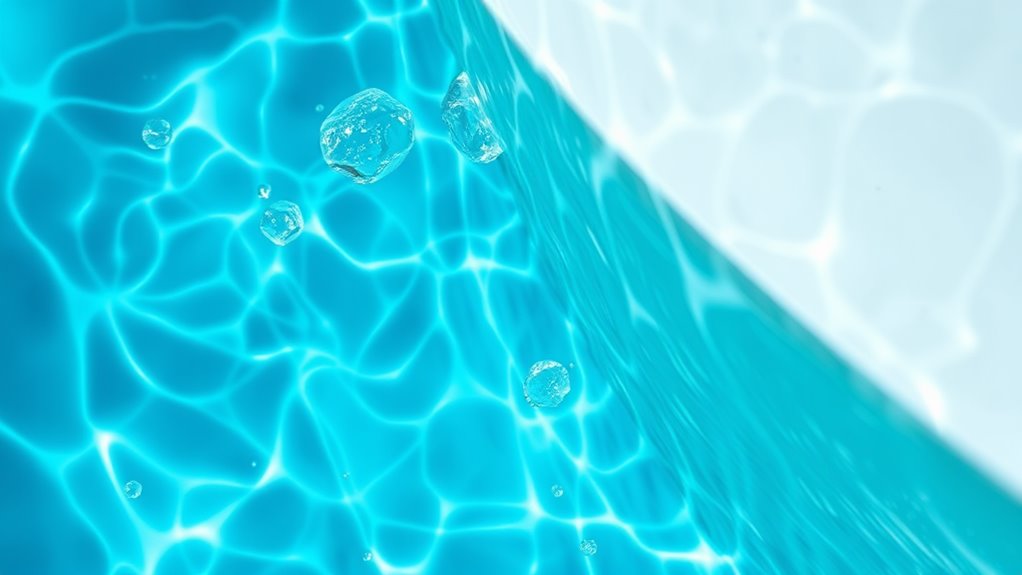
Copper-based solutions effectively kill mustard algae within 24-48 hours of proper application, making them a reliable treatment option for your pool. You'll need to carefully monitor copper levels to maintain concentrations between 0.5-1.0 ppm, as exceeding these guidelines can cause staining and potential health concerns. For ideal results, add copper sulfate products directly to your pool's deep end while the pump is running, and maintain proper pH levels between 7.2-7.6 during treatment.
Copper Sulfate Kill Rate
Studies have shown that copper sulfate solutions eliminate mustard algae within 24-48 hours when properly dosed at 1.0-1.5 ppm (parts per million). The copper sulfate effectiveness depends on maintaining consistent levels throughout the treatment period. You'll need to monitor your copper sulfate dosage carefully to achieve the best results.
For maximum kill rate, follow these critical steps:
- Test your pool's pH level and adjust to 7.2-7.6
- Maintain free chlorine at 2-4 ppm during treatment
- Run your pool filter continuously for 24 hours
- Brush affected areas thoroughly every 6 hours
The kill rate accelerates when water temperature exceeds 70°F (21°C). If you're not seeing results within 48 hours, you may need to recheck your chemical balance and copper sulfate concentration levels. Keep in mind that proper circulation is essential for effective treatment.
Copper Safety Guidelines
Although copper-based algaecides effectively combat mustard algae, you'll need to follow strict safety guidelines to prevent potential health risks and pool damage. Never exceed 1.0 ppm of copper concentration, as higher levels can lead to copper toxicity and staining of pool surfaces. Test your water's copper levels every 48 hours when using these treatments.
You'll want to maintain your pool's pH between 7.2-7.6 to prevent copper precipitation. If you're concerned about copper toxicity, consider copper alternatives like polyquat algaecides. When handling copper-based products, always wear protective gear, including chemical-resistant gloves and safety goggles. Store these chemicals in a cool, dry place away from direct sunlight and other pool chemicals to prevent dangerous reactions.
Application And Dosage Tips
When applying copper-based algaecides, you'll need to dilute the solution in a 5-gallon bucket of pool water before broadcasting it around your pool's perimeter. Proper application techniques and dosage accuracy are essential for effective mustard algae treatment.
For ideal results, follow these essential steps:
- Calculate your pool's volume precisely to determine the correct chemical amount
- Test copper levels before adding more – don't exceed 0.3 ppm
- Apply during evening hours to prevent UV degradation
- Run your pool pump for at least 8 hours after treatment
Remember to brush the affected areas thoroughly before and after treatment. If you're using a copper-based product with other chemicals, maintain a 24-hour interval between applications to prevent unwanted reactions and guarantee maximum effectiveness.
Quaternary Ammonium Compounds
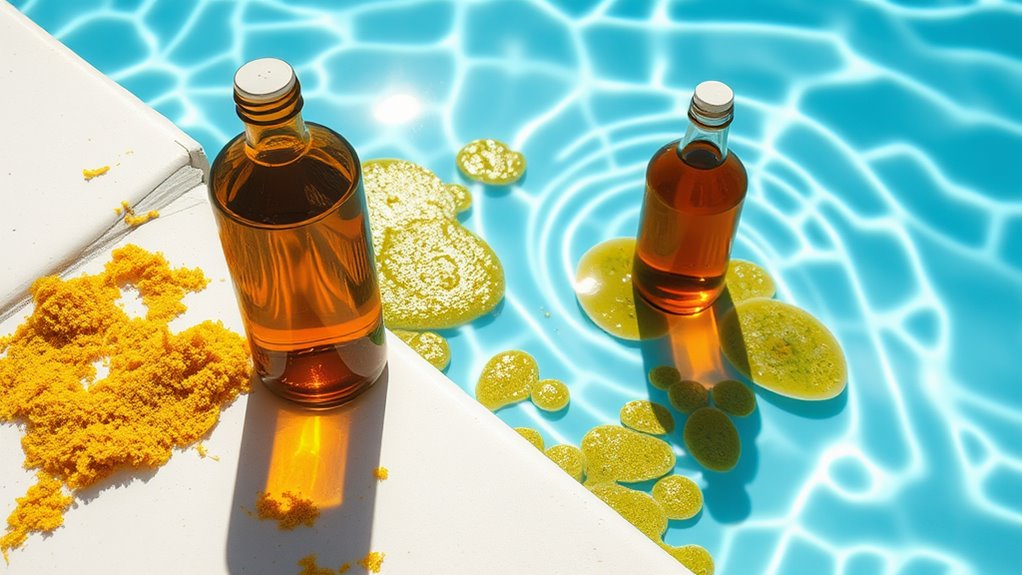
Quaternary ammonium compounds, commonly known as "quats," serve as powerful algaecides that effectively combat mustard algae in swimming pools. These specialized chemicals disrupt the algae's cell membranes, causing rapid death of the organisms. When you're dealing with stubborn mustard algae, quaternary compounds offer a targeted solution that's particularly effective in areas with high organic contamination.
For ideal pool maintenance, you'll need to apply quats directly to affected areas while your pool's filtration system is running. These compounds work best when you maintain proper pH levels between 7.2 and 7.6. You'll typically see results within 24-48 hours, though some strains may require repeated treatments. Unlike other algaecides, quats won't cause foaming or staining, making them an excellent choice for regular preventive treatment.
Concentrated Chlorine Tablets
Beyond chemical additives like quats, concentrated chlorine tablets represent a fundamental weapon against mustard algae. These tablets provide powerful sustained chlorination that's essential for killing and preventing yellow algae growth. You'll find significant concentrated chlorine benefits when using these tablets in your pool maintenance routine.
Concentrated chlorine tablets deliver powerful, sustained sanitization to eliminate and prevent mustard algae in your swimming pool.
For maximum effectiveness and concentrated chlorine safety, follow these critical steps:
- Maintain proper tablet dissolution by using an automatic chlorinator
- Keep tablets away from direct sunlight and store in a cool, dry place
- Never mix different types of chlorine tablets together
- Handle tablets with protective gloves and avoid breathing fumes
You'll need to maintain a chlorine level between 2-4 ppm when using tablets, ensuring consistent sanitization while preventing algae regrowth. Regular testing helps optimize your tablet usage and treatment effectiveness.
Multi-Action Algae Eliminators
Multi-action algae eliminators deliver three essential functions in combating mustard algae: they kill existing colonies, prevent regrowth, and clarify pool water simultaneously. These advanced formulas combine multiple active ingredients that work synergistically for thorough algae prevention and improved pool maintenance.
You'll find these products particularly effective because they contain specialized polymers that break down mustard algae's protective barrier while depositing a microscopic protective shield on pool surfaces. This shield continues working for several weeks after application. For best results, you'll need to maintain proper pH levels between 7.2 and 7.6 while using these eliminators. Most multi-action products are non-metallic and won't stain your pool's surface, making them ideal for all pool types, including vinyl and fiberglass.
Professional-Grade Pool Sanitizers
Professional-grade pool sanitizers offer you powerful solutions for eliminating stubborn mustard algae through concentrated chlorine shock treatments that rapidly oxidize algae cells. You'll find copper-based algaecide solutions particularly effective at penetrating the algae's protective layers while preventing future growth. Quaternary ammonium compounds provide a supplementary layer of sanitation by disrupting the cellular membranes of mustard algae, making them especially useful in conjunction with other treatments.
Concentrated Chlorine Shock Treatments
Powerful concentrated shock treatments containing calcium hypochlorite or lithium hypochlorite serve as essential weapons against stubborn mustard algae infestations. You'll need to apply these treatments at 2-3 times the normal shock dosage to achieve maximum chlorine effectiveness against yellow algae.
For peak results when shocking your pool, follow these critical steps:
- Test and balance your pool's pH between 7.2-7.6
- Add shock treatment at dusk or nighttime to prevent UV degradation
- Run your pool filter continuously for 24 hours after treatment
- Maintain proper shock treatment frequency of every 2-3 days until algae clears
Remember that concentrated shock products typically contain 65-75% available chlorine, making them considerably more potent than standard chlorine. You'll need to carefully measure and distribute the shock evenly across your pool's surface.
Copper-Based Algaecide Solutions
Copper-based algaecides represent one of the most effective secondary treatments against mustard algae, with metallic copper ions actively disrupting the algae's cellular structure. You'll find these solutions particularly effective when used alongside chlorine shock treatments, as they provide a powerful one-two punch against stubborn algae colonies.
When applying copper algaecide, you'll need to carefully monitor copper toxicity concerns, as excessive levels can stain pool surfaces and potentially irritate swimmers' skin and eyes. For ideal copper algaecide effectiveness, maintain levels between 1.0 and 1.5 ppm, and always test your water before adding more product. It is crucial to follow the manufacturer's dosing instructions precisely, as overdosing won't improve results but will increase risks of copper precipitation and staining.
Quaternary Ammonium Compounds
While copper-based solutions target algae directly, quaternary ammonium compounds (QACs) work by disrupting the cell membranes of mustard algae through their cationic surfactant properties.
When using QACs in your pool, you'll need to conduct regular efficacy assessments to verify peak performance. These quaternary ammonium treatments are particularly effective when used as part of a thorough sanitization strategy.
For maximum effectiveness, follow these critical steps:
- Test your pool's pH level before application
- Remove debris and vacuum the pool thoroughly
- Apply the QAC solution during peak sunlight hours
- Maintain proper circulation for 24-48 hours post-treatment
You'll find that QACs are most effective when water temperatures exceed 65°F (18°C), making them ideal for treating mustard algae during warmer months.
Frequently Asked Questions
How Long Should I Wait Before Swimming After Treating Mustard Algae?
For swimming safety, you'll need to wait at least 24 hours after treating mustard algae before entering the pool. Test the chemical balance before swimming to verify chlorine levels have returned to 1-3 ppm and pH is between 7.2-7.6. If you've used extra algaecides, wait 48 hours for ideal safety. Don't rush back in – proper chemical stabilization is vital for your health and effective algae treatment.
Can Mustard Algae Spread to Towels and Pool Equipment?
Yes, mustard algae can easily spread through towel contamination and pool equipment. You'll need to be vigilant about equipment sanitation since this stubborn algae clings to swimsuits, towels, floats, brushes, and other pool accessories. It is crucial to sanitize all equipment with a bleach solution or pool-grade disinfectant. Don't reuse contaminated items until they're properly cleaned, or you'll risk reinfecting your pool even after treatment.
Why Does Mustard Algae Keep Coming Back After Treatment?
Mustard algae keeps returning because it's developed algae resistance to standard treatments, much like bacteria becoming antibiotic-resistant. If you're not maintaining proper treatment frequency or using the correct chemical concentrations, you're allowing surviving spores to regenerate. Furthermore, you might be missing hidden spores in your pool's shaded areas, corners, or equipment. To prevent recurrence, you'll need consistent, thorough treatments and proper chemical balance maintenance.
Is Mustard Algae Harmful to Human Health?
While mustard algae isn't typically toxic, you shouldn't ignore its potential health risks. It can harbor harmful bacteria and create an environment where other dangerous microorganisms thrive. You might experience skin irritation, eye infections, or respiratory issues if you're exposed to water containing mustard algae. Furthermore, the algae's presence can reduce chlorine effectiveness, allowing more dangerous pathogens to survive in your pool water.
What Causes Mustard Algae to Grow in Swimming Pools?
You'll find mustard algae thriving in your pool when specific conditions align. Poor water chemistry, particularly low chlorine levels and unbalanced pH, creates an ideal environment. If you're not maintaining proper filtration or circulation, these yellow-brownish spores can quickly establish colonies. Warm temperatures, direct sunlight, and high phosphate levels also contribute to growth. For effective algae prevention tips, you'll need to address these factors systematically through regular maintenance.
